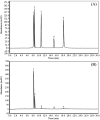Intervention effects of lotus leaf flavonoids on gastric mucosal lesions in mice infected with Helicobacter pylori
- PMID: 35517367
- PMCID: PMC9055112
- DOI: 10.1039/d0ra03311a
Intervention effects of lotus leaf flavonoids on gastric mucosal lesions in mice infected with Helicobacter pylori
Abstract
Helicobacter pylori (H. pylori) is one of the main factors that cause gastric lesions. The lotus leaf is an edible plant used in traditional Eastern medicine. This study evaluates the intervention effects of lotus leaf flavonoids (LLF) on gastric mucosal lesions in mice infected with H. pylori and explores their mechanism of action. High-performance liquid chromatography analysis reveals that LLF contain kaempferitrin (kaempferol-3,7-dirhamnoside), hypericin, astragalin (kaempferol-3-glucoside), phlorizin, and quercetin. LLF can reduce the number of gastric mucosal lesions and tissue lesions in mice with H. pylori-induced gastric lesions. LLF can increase the levels of somatostatin and vasoactive intestinal peptide in the serum of mice with gastric lesions and decrease the levels of substance P and endothelin-1 to inhibit gastric lesions. LLF can also reduce the levels of interleukin (IL)-6, IL-12, tumor necrosis factor (TNF)-α, and interferon-gamma cytokines in the serum of mice with gastric lesions. Using a quantitative polymerase chain reaction assay it can be seen that LLF can downregulate mRNA expressions of TNF-α, IL-1β, myeloperoxidase, keratin (KRT) 16, KRT6b, and transglutaminase 3 epidermal in the gastric tissues of mice with gastric lesions. Western blot analysis indicates that LLF can downregulate the protein expressions of caspase-1, Nod-like receptor protein 3, IL-1β, TNF-α, and Toll-like receptor 4 in the gastric tissues of mice with gastric lesions. LLF have beneficial effects on gastric lesions induced by H. pylori. Meanwhile LLF is more active in competition with ranitidine. LLF represent an active substance that can inhibit H. pylori-induced gastric lesions. The flavones of LLF may enhance the inhibition of gastric mucosal lesions by promoting the interaction between the compounds.
This journal is © The Royal Society of Chemistry.
Conflict of interest statement
No conflicts of interest in this article.
Figures






Similar articles
-
Lotus leaf flavonoids induce apoptosis of human lung cancer A549 cells through the ROS/p38 MAPK pathway.Biol Res. 2021 Mar 2;54(1):7. doi: 10.1186/s40659-021-00330-w. Biol Res. 2021. PMID: 33653412 Free PMC article.
-
Improvement Effect of Lotus Leaf Flavonoids on Carbon Tetrachloride-Induced Liver Injury in Mice.Biomedicines. 2020 Feb 24;8(2):41. doi: 10.3390/biomedicines8020041. Biomedicines. 2020. PMID: 32102401 Free PMC article.
-
Structural, in vitro digestion, and fermentation characteristics of lotus leaf flavonoids.Food Chem. 2023 Apr 16;406:135007. doi: 10.1016/j.foodchem.2022.135007. Epub 2022 Nov 19. Food Chem. 2023. PMID: 36473390
-
Chemoprevention of Helicobacter pylori-associated gastric carcinogenesis in a mouse model: is it possible?J Biochem Mol Biol. 2003 Jan 31;36(1):82-94. doi: 10.5483/bmbrep.2003.36.1.082. J Biochem Mol Biol. 2003. PMID: 12542979 Review.
-
The biological functions of IL-17 in different clinical expressions of Helicobacter pylori-infection.Microb Pathog. 2015 Apr;81:33-8. doi: 10.1016/j.micpath.2015.03.010. Epub 2015 Mar 13. Microb Pathog. 2015. PMID: 25773771 Review.
Cited by
-
Chalcones and Gastrointestinal Cancers: Experimental Evidence.Int J Mol Sci. 2023 Mar 22;24(6):5964. doi: 10.3390/ijms24065964. Int J Mol Sci. 2023. PMID: 36983038 Free PMC article. Review.
-
Effect of lemon peel flavonoids on UVB-induced skin damage in mice.RSC Adv. 2020 Aug 26;10(52):31470-31478. doi: 10.1039/d0ra05518b. eCollection 2020 Aug 21. RSC Adv. 2020. PMID: 35520688 Free PMC article.
-
Mesenchymal Stem Cells Accelerate Recovery of Acetic Acid-Induced Chronic Gastric Ulcer by Regulating Ekt/Akt/TRIM29 Axis.Stem Cells Int. 2024 Jan 3;2024:6202123. doi: 10.1155/2024/6202123. eCollection 2024. Stem Cells Int. 2024. PMID: 38213743 Free PMC article.
References
LinkOut - more resources
Full Text Sources
Research Materials
Miscellaneous

